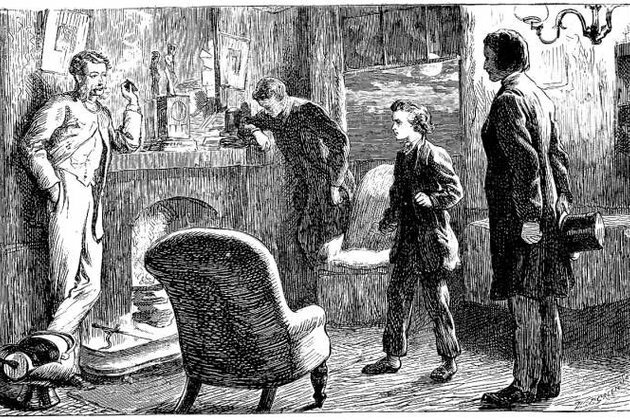Charles Dickens: using data analysis to shed new light on old characters
The Conversation
07 Jun 2020, 02:10 GMT+10

Dickens created some of the best-known characters in fiction. The likes of Ebenezer Scrooge, Oliver Twist and David Copperfield are still well-remembered, 150 years after his death - and are regularly updated through new stage and screen adaptions. One of the reasons why his characters have become part of popular culture is Dickens's ability to exaggerate and caricature but at the same time also deeply understand human character.
Behaviours that he describes in his novels still resonate today, as in a recent comment by a political editor who describes a lack of decisive action on coronavirus as a "Micawberish conviction in government that something would turn up", in reference to Dickens's memorable comic hero and unshakeable optimist in David Copperfield.
Read more: David Copperfield on screen: Charles Dickens' masterpiece is a celebration of everyday heroes
The striking and individualising features of his characters have received much critical and popular attention. Yet, crucial to Dickens's authorial techniques - and hence the public's love of his characters - is also the description of conventional ways of behaving. Common features make fictional people more like normal people. As with anything in life, we don't quite notice what's "normal" until it isn't any more.
This is where digital methods come in. Treating Dickens's novels as a dataset makes it possible to identify patterns based on formal repetitions and frequencies - the type of information we are not consciously aware of when we a read a novel.
A common stance
Analysing Dickens's novels as one single dataset (or "corpus") shows us that, as in normal life, a type of common behaviour is that people often have or put their hands in their pockets, as Fledgeby in Our Mutual Friend.
When we read a novel, such a description can easily go unnoticed. Why would we pay particular attention to what people do with their hands - unless it is clearly meaningful.
It's the same in real life - we would not normally pick up on body language, unless it strikes us as unusual and unfamiliar. But looking at several novels at the same time makes patterns of repeated and commonly occurring behaviours more clearly visible.
This can be achieved with the help of a "concordance" tool that displays all occurrences of a word or phrase with a specified amount of context to the left and right. Below is a sample from a concordance for the phrase "his hands in his pockets" in Dickens's novels, retrieved with the free web application CLiC.
Importantly, it is not only Dickens who depicts such everyday behaviour. We find examples in other 19th-century fiction, too:
While such phrases often appear circumstantial rather than central to plot or character, they fulfil important functions in drawing the reader into the text. The description of conventional behaviour makes fictional people more like real people, subtly creating a link between what the reader knows about how people "normally" behave or how fictional people are generally depicted across novels.
What, however, is the norm that we measure fictional characters against? Behaviours and body language change over time. So it is little surprise that in the 19th century it was mainly men who were described with their hands in their pockets.
Depicting power
Exploiting conventions and subtleties also enabled Dickens to draw attention to exceptional behaviours. Another common pattern of body language that occurs across 19th-century fiction is men standing with their back to the fire, a pose connected to power and confidence of the man of the house.
In Dickens, we also find a woman, Mrs Pipchin (in Dombey and Son), who is depicted in a situation where she stands with her back to the fire. This is no coincidence. As a widow, Mrs Pipchin looks after herself, and the way in which she runs her boarding house for children does not show her to be a character who displays stereotypical, female qualities.
The interplay of norms and deviations from norms also becomes apparent in the wide range of body language references that Dickens uses. References to eyes are generally common in fiction, as can be shown with frequency data retrieved by tools like CLiC. Typical patterns we find in Dickens (and elsewhere) concern the direction and duration of gaze.
Body parts that are less frequent are teeth. So using teeth in a similar way to eyes makes these body parts a more strikingly characterising feature.
With Dickens's ability to both create individualised, memorable characters as well as subtly connect to our experience of encountering people more generally, his novels still speak to readers today.
The contexts in which modern readers interact with the texts have changed, and in today's digital world we can draw on new tools to view and understand the people Dickens has given us. After 150 years, we not only remember Dickens's fictional characters, but we can still find out more about them.
Authors: Michaela Mahlberg - Professor of Corpus Linguistics, University of Birmingham | Viola Wiegand - Research Fellow, Department of English Language and Linguistics, University of Birmingham 
 Share
Share
 Tweet
Tweet
 Share
Share
 Flip
Flip
 Email
Email
Watch latest videos
Subscribe and Follow
Get a daily dose of Australian Herald news through our daily email, its complimentary and keeps you fully up to date with world and business news as well.
News RELEASES
Publish news of your business, community or sports group, personnel appointments, major event and more by submitting a news release to Australian Herald.
More InformationInternational
SectionPolicy debates in South Korean election drowned by personal attacks
SEOUL, South Korea: South Korea's upcoming presidential election has turned into a messy battle full of personal insults and scandals...
Over 25,000 flee as smoke from fires worsens air quality in Canada, US
FLIN FLON, Manitoba: More than 25,000 people in three Canadian provinces have been forced to leave their homes because of wildfires,...
Safety programs for fishermen, farmers at risk under Trump cuts
NEWBURYPORT, Massachusetts: Aboard a burning fishing boat more than 100 miles offshore, Robbie Roberge knew precisely what to do. He...
Starmer pledges war readiness with 1.5 billion pound defense boost
LONDON, UK: As global tensions rise and Europe's defense posture shifts, the UK is ramping up its military readiness with a 1.5 billion...
AstraZeneca pill slows cancer when guided by early blood test
CHICAGO, Illinois: A simple blood test could help breast cancer patients get the proper treatment earlier, potentially halving their...
Czech minister quits after ministry sells $45 million in bitcoins
PRAGUE, Czech Republic: Czech Justice Minister Pavel Blažek resigned this week because of a scandal involving bitcoins. Earlier this...
Sydney
SectionWage boost in Australia as inflation falls and economy stabilizes
SYDNEY, Australia: Australia's independent wage-setting body, the Fair Work Commission (FWC), has announced a 3.5 percent increase...
AFP Helps Bust International Sextortion Ring After Teen Deaths
SYDNEY, NSW, Australia - A major international operation targeting online sextortion has resulted in the arrest of 22 suspects in Nigeria,...
South Africa provide hints to WTC25 Final batting line-up in warm up fixture against Zimbabwe
New Delhi [India] June 6 (ANI): South Africa's batting line-up for the World Test Championship Final has been hinted at through their...
Rob Walter named New Zealand men's cricket head coach across all formats
New Delhi [India] June 6 (ANI): New Zealand Cricket have confirmed the appointment of Rob Walter as men's national team head coach,...
US Vice President Vance expressed complete support for India's fight against terrorism: Tejasvi Surya
Washington, DC [US], June 6 (ANI): BJP MP Tejasvi Surya, who is a member of all-party delegation led by Congress MP Shashi Tharoor,...
US Vice President Vance totally supportive of India's stand on Pahalgam and aftermath: Shashi Tharoor calls meeting "excellent"
Washington, DC [US], June 6 (ANI): Congress MP Shashi Tharoor, who is leading an all-party delegation to the US, called the meeting...













